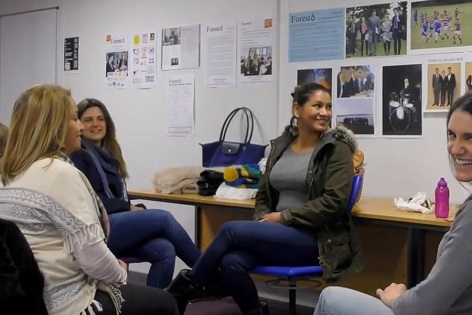At the University of Reading, some of our education-themed research within CeLM has indicated the benefits for multilingual children and young people of maintaining their home languages. For example, emerging findings from our Linguistic Creativity in Language Learning project are that Year 9 pupils who report a home language in addition to English are more positive about learning languages and see themselves as future languages users.
In the blog below, we focus on how complementary schools are about even more than the important work of maintaining home languages, and in doing so we draw on the wonderful work going on at Clubinho Verde Amerelo, a complementary school for the Brazilian community in Reading.
Complementary schools are created and managed by members of a community and promote promote home languages and literacy for children with linguistic and cultural heritages that are other than British. These schools play an important role in supporting the life of the communities they serve. In the UK, there are three to five thousand complementary schools which constitute a “safe space for pupils to practice their multilingual identities” (Li Wei 2014: 162).
On our visit to Clubinho Verde Amerelo, Bilingualism Matters@Reading had the pleasure of filming the classroom activities that support Brazilian children’s linguistic and cultural growth. Below, you can read a reflection by Roberta Luchini Boschi, the teachers’ coordinator at Clubinho Verde Amarelo. You can also watch a video at the end of this article, which includes a short interview with one of the teachers and a parent of a child attenting the school.
Dr Naomi Flynn and Dr Anna Wolleb
Roberta’s reflection
Complementary schools are an important tool to foster the development of other languages. More than just a place to learn, the meetings between children and also parents can end up creating a community that shares not only language, but also culture and which generates friendships.
In terms of learning, each school chooses what they teach their students. Our school is called ‘Clubinho Verde Amarelo’ and has the intention of developing the Portuguese language among children; helping them to read, write, speak and increase their vocabulary. The learning process includes playing Brazilian games, singing songs and preparing parties for important annual occasions in Brazil such as Carnival and Saint John’s.
It is important to highlight that a complementary school cannot “do the job” by itself. A few hours per week will not make the children fluent in a second language. It needs to be a partnership between the family and the school. So here are some questions the family has to consider when they decide to take on the challenge of teaching their home language at home:
Is the family ready to give enough contact with their home language when they spend time together?
If one person in the family (either the father or mother) is not fluent in the second language, would they be fine not understanding what is going on?
If the child says he or she does not want to learn the language, should the parents insist?
How does the dynamic of the family work?
Can children always make their own choices?
Complementary schools are normally capable of raising the interest in a language, making the classes fun, bringing new cultural elements into the child’s life, helping to develop the skills to help the child to be confident when using the second language. But the family needs to do their part when the child is at home.
In our school we provide some homework, books to be read, challenges to be completed, as attempts to make the family use Portuguese at home at least when they are doing the activities. As the teachers’ coordinator, I try to help our volunteer teachers to prepare classes that will entertain the children and in some cases teach them without them noticing. I work together with the teachers and parents as a team to develop in the children a love and respect for our country, language and culture.
If you’ve developed an interest after watching this video, and want to know more about our school, look at our website send us an e-mail at dmingroup@clubinhoverdeamarelo.co.uk or find us on Facebook here.


